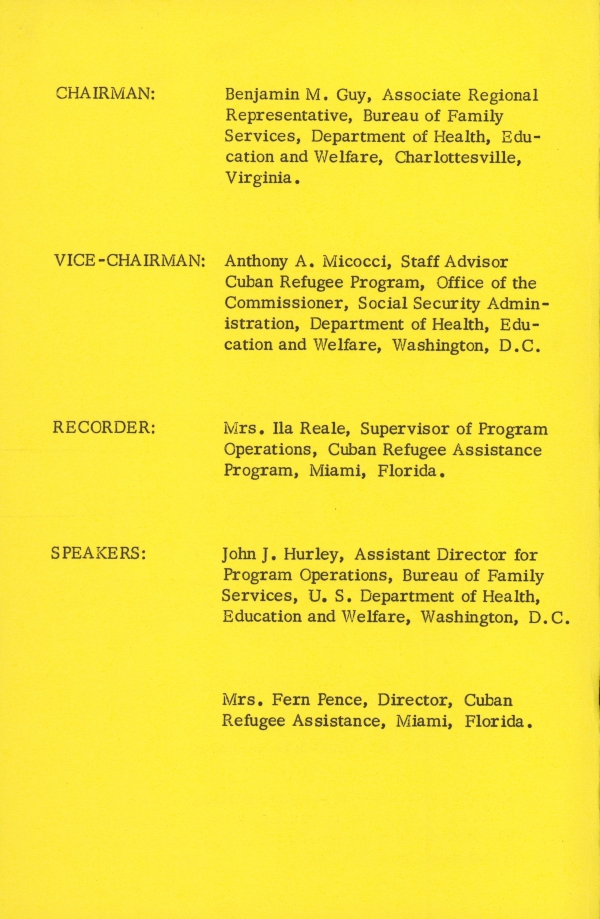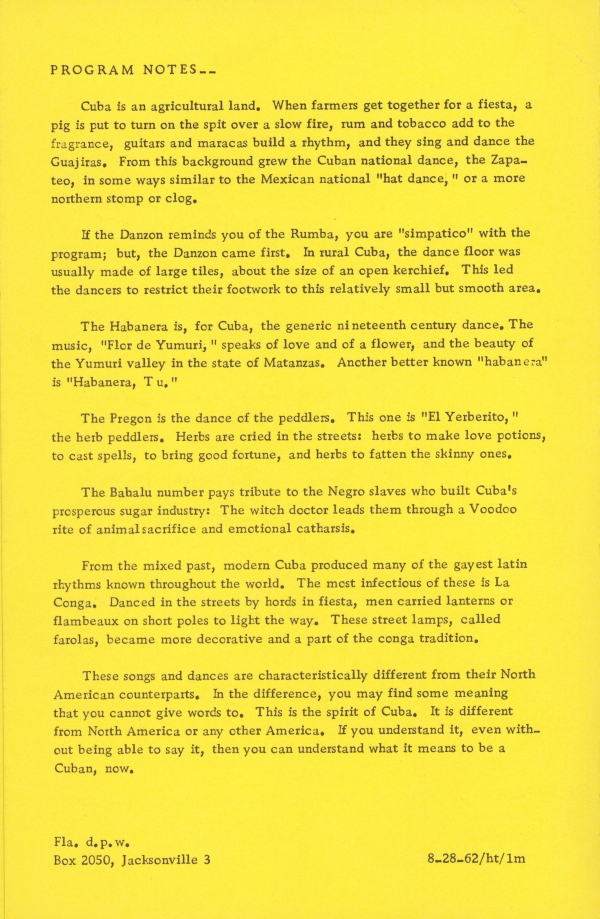Florida Memory is administered by the Florida Department of State, Division of Library and Information Services, Bureau of Archives and Records Management. The digitized records on Florida Memory come from the collections of the State Archives of Florida and the special collections of the State Library of Florida.

State Archives of Florida
- ArchivesFlorida.com
- State Archives Online Catalog
- ArchivesFlorida.com
- ArchivesFlorida.com
State Library of Florida
Related Sites

Description of previous item
Description of next item

American Public Welfare Association session on Cuban refugee assistance, 1962 - program
Source
Description
Date
Contributors
Format
Coverage
Topic
Subjects
Geographic Term
Narration: Mrs. Ofelia Puig de Alvarez
"Cuba... through its Dances and Songs"
I. Guajira. A peasant dance.
Zapateo. Cuban national dance.
Guajiras. Typical Cuban songs.
Danzon. A typical dance.
II. Habanera. A nineteenth century dance.
III. Pregon: A cha-cha, the herb peddlers.
IV. Babalu. Slaves worship their god Babalue through emotional dances and songs.
V. Carnival. The case of the entire show in the gayest Cuban dance: La Conga.
VI. Transition (1959-1962)
VII. God Bless America.
After this meeting, the program participants will circulate in the hotel lobby so you may have an opportunity to discuss with them informally the subject matter of this special session.
Title
Description
Source
Date
Contributor
Format
Language
Type
Identifier
Coverage
Geographic Term
Thumbnail
Display Date
ImageID
topic
Subject - Corporate
Subject - Person
Transcript
CUBAN REGUGEE ASSISTANCE
Special Session
Southeast Regional Conference
American Public Welfare Association
Americana Hotel, Sept. 5, 1962
Grand Balltoom, 7:30 P.M.
CHAIRMAN: Benjamin M. Guy, Associate Regional Representative, Bureau of Family Services, Department of Health, Education and Welfare, Charlottesville, Virginia.
VICE-CHAIRMAN: Anthony A. Micocci, Staff Advistor Cuban Refugee Program, Office of the Commissioner, Social Security Administration, Department of Health, Education and Welfare, Washington, D.C.
RECORDER: Mrs. Ila Reale, Supervisor of Program Operations, Cuban Refugee Assistance Program, Miami, Florida.
SPEAKERS: John J. Hurley, Assistant Director for Program Operations, Bureau of Family Services, U.S. Department of Health, Education and Welfare, Washington, D.C.
Mrs. Fern Pence, Director, Cuban Refugee Assistance, Miami, Florida.
Narration: Mrs. Ofelia Puig de Alvarez
"Cuba... through its Dances and Songs"
I. Guajira. A peasant dance.
Zapateo. Cuban national dance.
Guajiras. Typical Cuban songs.
Danzon. A typical dance.
II. Habanera. A nineteenth century dance.
III. Pregon: A cha-cha, the herb peddlers.
IV. Babalu. Slaves worship their god Babalue through emotional dances and songs.
V. Carnival. The case of the entire show in the gayest Cuban dance: La Conga.
VI. Transition (1959-1962)
VII. God Bless America.
After this meeting, the program participants will circulate in the hotel lobby so you may have an opportunity to discuss with them informally the subject matter of this special session.
PROGRAM NOTES --
Cuba is an agricultural land. When farmers get togetehr for a fiesta, a pig is put to turn on the spit over a slow fire, rum and tabacco add to the fragrance, guitars and maracas build a rhythm, and they sing and dance the Guajiras. From this background grew the Cuban national dance, the Zapateo, in some ways similar to the Mexican national "hat dance," or a more northern stomp or clog.
If the Danzon reminds you of the Rumba, you are "simpatico" with the program; but, the Danzon came first. In rural Cuba, the dance floow was usually made of large tiles, about the size of an open kerchief. This led the dances to restrict their footwork to this relatively small but smooth area.
The Habanera is, for Cuba, the generic nineteenth century dance. The music, "Flor de Yumuri," speaks of love and of a flower, and the beauty of the Yumuri valley in the state of Matanzas. Another better known "habanera" is "Habanera, Tu."
The Pregon is the dance of the peddlers. This one is "El Yerberito," the herb peddlers. Herbs are cried in the streets; herbs to make love potions, to cast spells, to bring good fortune, and herbs to fatten the skinny ones.
The Babalu number pays tribue to the Negro slaves who built Cuba's prosperous sugar industry: The witch doctor leads them through a Voodoo rite of animal sacrifice and emotional catharsis.
From the mixed past, modern Cuba produced many of the gayest Latin rhythms known throughout the world. The most infectious of these is La Conga. Dances in the streets by hords in fiesta, men carried lanters or flambeaux on short poles to light the way. These street lamps, called farolas, became more decorative and aprt of the conga tradition.
These songs and dances are cahracteristically different from their North american counterparts. In the difference, you may find some meaning that you cannot give words to. This is the spirit of Cuba. It is different from North America or any other America. If you understand it, even with out being able to say it, then you can understand what it means to be a Cuban, now.
Fla. d.p.w.
Box 2050, Jacksonville 3
8_28_62/ht/1m
Chicago Manual of Style
American Public Welfare Association session on Cuban refugee assistance, 1962 - program. 1962. State Archives of Florida, Florida Memory. <https://www.floridamemory.com/items/show/297498>, accessed 17 November 2025.
MLA
American Public Welfare Association session on Cuban refugee assistance, 1962 - program. 1962. State Archives of Florida, Florida Memory. Accessed 17 Nov. 2025.<https://www.floridamemory.com/items/show/297498>
AP Style Photo Citation

 Listen: The Latin Program
Listen: The Latin Program

